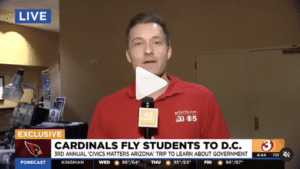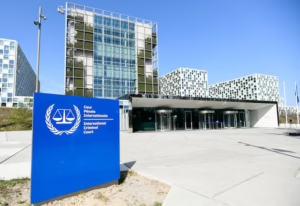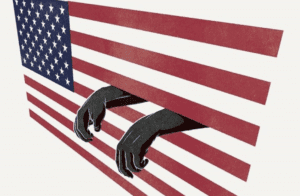 America in One Room students processed today’s election news in real time, capturing first-time voters’ reactions to President Biden’s withdrawal from his campaign, including NBC’s interview with @americain1room attendee Tyler Kunkowski.
America in One Room students processed today’s election news in real time, capturing first-time voters’ reactions to President Biden’s withdrawal from his campaign, including NBC’s interview with @americain1room attendee Tyler Kunkowski.
 America in One Room students processed today’s election news in real time, capturing first-time voters’ reactions to President Biden’s withdrawal from his campaign, including NBC’s interview with @americain1room attendee Tyler Kunkowski.
America in One Room students processed today’s election news in real time, capturing first-time voters’ reactions to President Biden’s withdrawal from his campaign, including NBC’s interview with @americain1room attendee Tyler Kunkowski.
 Close Up President Mia Charity gives @arizonasfamily a glimpse into this civics-centered program for 200+ Arizona students in the nation’s capital, in partnership with the office of Governor Katie Hobbs and the Arizona Cardinals.
Close Up President Mia Charity gives @arizonasfamily a glimpse into this civics-centered program for 200+ Arizona students in the nation’s capital, in partnership with the office of Governor Katie Hobbs and the Arizona Cardinals.
 Karim Khan, prosecutor of the International Criminal Court (ICC), announced on May 20 that he has applied for arrest warrants for leaders of Hamas and Israel for war crimes and crimes against humanity over the October 7 attacks on Israel and the subsequent war in Gaza. A panel of judges will now consider Khan’s application for warrants for Yahya Sinwar, head of Hamas in the Gaza Strip; Mohammed Diab Ibrahim Al-Masri, commander-in-chief of the military wing of Hamas; Ismail Haniyeh, head of Hamas’ Political Bureau; Israeli Prime Minister Benjamin Netanyahu; and Israeli Minister of Defense Yoav Gallant.1
Karim Khan, prosecutor of the International Criminal Court (ICC), announced on May 20 that he has applied for arrest warrants for leaders of Hamas and Israel for war crimes and crimes against humanity over the October 7 attacks on Israel and the subsequent war in Gaza. A panel of judges will now consider Khan’s application for warrants for Yahya Sinwar, head of Hamas in the Gaza Strip; Mohammed Diab Ibrahim Al-Masri, commander-in-chief of the military wing of Hamas; Ismail Haniyeh, head of Hamas’ Political Bureau; Israeli Prime Minister Benjamin Netanyahu; and Israeli Minister of Defense Yoav Gallant.1
What Is the International Criminal Court?
The ICC is a criminal court located in The Hague, in the Netherlands, which brings cases against individuals for charges of genocide, war crimes, crimes against humanity, and crimes of aggression. It operates independently of other international organizations, such as the United Nations, and is separate from the UN International Court of Justice.2
The ICC was founded in 1998 by a treaty and entered into force in 2002. As of 2024, 124 countries are members of the court; Palestine is recognized as a member, but Israel, as well as the United States, Russia, China, and others, are not.3 If the ICC grants Khan’s application and issues arrest warrants for any of the five men, any country that is a member would have to arrest them and extradite them to The Hague.4
The ICC currently has arrest warrants for world leaders such as Russian President Vladimir Putin, for leading the invasion of Ukraine, and former Sudanese President Omar al-Bashir, for directing a campaign of mass killing and rape in the Darfur region.5
What Are the Charges?
The charges against Sinwar, Haniyeh, and al-Masri include “extermination, murder, taking of hostages, rape, and sexual assault in detention.” Hamas militants killed approximately 1,200 people and took at least 245 hostages in the October 7 attack on Israel. The charges against Netanyahu and Gallant include “causing extermination, causing starvation as a method of war, including the denial of humanitarian relief supplies, deliberately targeting civilians in conflict.” When announcing the application, Khan said, “The fact that Hamas fighters need water doesn’t justify denying water from all the civilian population of Gaza.” The Ministry of Health in Gaza estimates that more than 35,500 Palestinians have been killed and more than 79,000 have been wounded in Gaza since October 7, but outside organizations have not been able to confirm those numbers.6
How Have World Leaders Responded?
Both Israeli and Hamas leaders have condemned Khan’s application. Netanyahu said the action was meant to target all of Israel. “I reject with disgust the comparison of the prosecutor in the Hague between democratic Israel and the mass murderers of Hamas,” he said. Hamas said in a statement that it “strongly condemns the attempts of the ICC Prosecutor to equate victims with aggressors by issuing arrest warrants against a number of Palestinian resistance leaders without legal basis.”7
In the United States, President Joe Biden issued a statement in defense of Israel. “Let me be clear: Whatever this prosecutor might imply, there is no equivalence—none—between Israel and Hamas,” he said. “We will always stand with Israel against threats to its security.”8
Congressional Republicans have also condemned the ICC’s arrest warrants. Speaker of the House Mike Johnson (R-La.) said the chamber may vote on sanctions against the ICC for seeking an arrest warrant against Netanyahu.9 Rep. Elise Stefanik (R-N.Y.), leader of the House Republican Conference, said, “The ICC is an illegitimate court that equivocates a peaceful nation protecting its right to exist with radical terror groups that commit genocide.”10
Not all Democrats agree with President Biden, however. Sen. Bernie Sanders (I-Vt.), who caucuses with Democrats, said in a statement, “The ICC prosecutor is right to take these actions. These arrest warrants may or may not be carried out, but it is imperative that the global community uphold international law. Without these standards of decency and morality, this planet may rapidly descend into anarchy, never-ending wars, and barbarism.”11 Rep. Mark Pocan (D-Wis.) said, “If Netanyahu comes to address Congress, I would be more than glad to show the ICC the way to the House floor to issue that warrant.”
International rights organizations such as Amnesty International and Human Rights Watch have released statements in favor of the ICC’s actions.12 Support is split in Europe, with leaders in France, Germany, and Belgium affirming the actions of the ICC and those of the United Kingdom and Czech Republic issuing press releases against the prosecutor’s inclusion of Israel with Hamas. The United States’ neighbor, Mexico, supports an investigation by the ICC.13 As of May 21, Canadian Prime Minister Justin Trudeau had not released a statement about the action.14
What Happens Next?
The ICC’s Pre-Trial Chamber will assess whether there are reasonable grounds to believe that the accused have committed a crime within the ICC’s jurisdiction. In past cases, the Pre-Trial Chamber has taken several months to decide whether to issue a warrant, and security experts expect the same for this case. The ICC does not have its own police force; therefore, it must rely on member countries to enforce the arrest warrants that it issues or the suspect to present themselves to the ICC voluntarily.15
Discussion Questions
Other Resources
As always, we encourage you to join the discussion with your comments or questions below.
Close Up is proud to be the nation’s leading nonprofit civic education organization, working with schools and districts across the country since 1971. If you would like to partner with us or learn more about our experiential learning programs, professional development, or curriculum design and consulting, contact us today!
Sources

In September 2023, New Mexico Gov. Michelle Lujan Grisham (D) declared gun violence in Albuquerque and the surrounding Bernalillo County a public health emergency, mirroring similar declarations during the COVID-19 pandemic. The declaration was accompanied by the immediate imposition of a 30-day ban on carrying firearms in public areas and state-owned property in the region. Gov. Lujan Grisham defended the move as a necessary step in protecting children; gun violence is the leading cause of death for children in the United States.
The move was met by criticism from both Republicans and Democrats in New Mexico, a state with relatively few prohibitions on firearm possession and carry. Several days after the emergency declaration, gun rights organizations filed lawsuits resulting in a judge temporarily preventing the new rules’ enforcement. Gov. Lujan Grisham narrowed the emergency measures to only temporarily prohibiting the carrying of firearms in Albuquerque-area public parks and playgrounds, a move which resulted in a federal judge allowing the rule to become effective in October.
Gun rights groups, such as the National Association for Gun Rights, and individuals filed lawsuits against the emergency declarations as unconstitutional. Plaintiffs and political critics of Gov. Lujan Grisham’s move have cited both the Second Amendment and the Supreme Court’s ruling in New York State Rifle & Pistol Association Inc. v. Bruen (2022). The Bruen case introduced a new way state regulations on firearm carry will be tested for constitutionality, limiting what both existing and new regulations can prohibit. Rep. Ted Lieu (D-Calif.) also voiced opposition to the rules as unconstitutional, though he stated he wanted stricter gun control. Opposition to the new rules, including the revised declaration prohibiting carry in only public parks and playgrounds, also reflects sentiment that the regulations prevent citizens from carrying a firearm for self-defense.
However, in the post-COVID environment, gun violence—particularly gun violence against children—has been increasingly treated as a public health crisis. Researchers at Tulane and Johns Hopkins Universities have studied this possible approach, and research released in 2023 by the Johns Hopkins Bloomberg School of Public Health’s Center for Gun Violence Solutions recognized broad support for gun violence and public health solutions. Support was found among 61.8 percent of gun owners and 54.4 percent of Republicans for publicly funded programs that include conflict mediation and other social services. The researchers’ recommendations also emphasized restricting public carry of firearms, which they considered a primary impact of gun violence.
Tulane’s research noted that certain gun control measures—such as expanding prohibitions on firearm purchases by domestic abusers—may have a significant impact. The research also identified approaches unrelated to gun control measures that could reduce gun violence, such as beautification programs that develop vacant properties and improve societal wellness. Tulane’s research praised Advanced Peace, a California organization that practices violence interruption. Violence interruption is a set of practices that prevent cyclical violence by focusing on expanding community resources for individuals at heightened risk of perpetrating gun violence.
Discussion Questions
As always, we encourage you to join the discussion with your comments or questions below.
Close Up is proud to be the nation’s leading nonprofit civic education organization, working with schools and districts across the country since 1971. If you would like to partner with us or learn more about our experiential learning programs, professional development, or curriculum design and consulting, contact us today!
Sources
Today, 25 percent of the world’s documented prison population is incarcerated in the United States. Despite America being the land of the free, there are more recorded prisoners here than in any other country: 2,068,800.

So, how did the United States get here? Over the last 40 years, numerous factors have contributed to the dramatic increase in the prison population. President Richard Nixon declared a “war on drugs” in 1971. Ensuing legislation, such as the Anti-Drug Abuse Act of 1986 and the Violent Crime Control and Law Enforcement Act of 1994, contributed to a rapid increase in the U.S prison population. Years earlier, even the 13th Amendment to the Constitution contributed to the growth of the prison population.
The 13th Amendment reads, “Neither slavery nor involuntary servitude, except as a punishment for crime whereof the party shall have been duly convicted, shall exist within the United States, or any place subject to their jurisdiction.” Some refer to this clause as the criminal-exception loophole, which allowed the economic benefits of slavery to continue by prosecuting and imprisoning Black Americans for petty, ill-defined crimes such as vagrancy.
After the Civil War, Southerners struggled with the sudden lack of free labor and the economy began to deteriorate. To offset that stress, some states began the practice of convict leasing and enforcing Black Codes. This allowed prisoners to be leased out for their labor to those who paid small leasing fees to the government. Because Black Codes criminalized freed slaves for frivolous reasons such as lack of employment, lack of housing, or participating in business other than husbandry, there was quickly a plethora of laborers to lease out.1
This loophole introduced long-term consequences that are still catching up with us today. The effects of the 13th Amendment and current laws continue to allow convicted felons to be compelled to work without pay. And some legislators regard the U.S.’s highest incarceration rate as a pressing current issue.
How Citizens Feel About Our High Incarceration Rate in America
In 2017, the American Civil Liberties Union (ACLU) Campaign for Smart Justice conducted a public poll to gain a greater understanding of how individuals view the high incarceration rate in America. Of those polled, 71 percent agreed that it is important to reduce America’s prison population. That 71 percent included 87 percent of Democrat respondents, 67 percent of independent respondents, and 57 percent of Republican respondents. The poll found that 68 percent of respondents would be more likely to vote for an elected official who supports reducing the prison population, and that 71 percent believe incarceration is counterproductive to public safety. Other studies and polls show similar results that liberals, conservatives, and moderates, for the most part, find some agreement on the high incarceration rate in America as a current issue.2
Sen. Charles Grassley (R-Iowa) and former Gov. Deval Patrick (D-Mass.) discuss sentencing reform and reducing rates of incarceration:
What Are Some Possible Solutions?
One proposed approach to reducing the incarceration rate is to begin back-pedaling on some laws passed with the Anti-Drug Abuse Act of 1986 and the 1994 Crime Bill. President Donald Trump signed into law the First Step Act of 2018, which passed Congress with overwhelming bipartisan support.3 The main goals of the law were sentencing and prison reform. The law gave sentencing power back to judges by allowing them to reduce sentences below the statutory minimum; offenders who were sentenced for crack-cocaine-related charges prior to 2010 were automatically allowed to apply for resentencing. There were also a multitude of reforms to how corrections officials treat prisoners and certain aspects of how the Department of Justice and attorney general interact with the Bureau of Prisons and the Department of Corrections to make living and labor conditions better for inmates.
READ: “Criminal Justice Reform: The First Step Act” on the Current Issues Blog
Another prospective solution is to amend the Constitution. In 2020, congressional Democrats proposed legislation to add an amendment to the Constitution that would eliminate the language that permits slavery and involuntary servitude as criminal punishment and make them unconstitutional under any conditions. Sen. Jeff Merkley (D-Ore.) argued for the bill’s passage, saying that the 13th Amendment “continued the process of a white power class gravely mistreating Black Americans, creating generations of poverty, the breakup of families, and this wave of mass incarceration that we still wrestle with today.” Former Rep. William Lacy Clay (D-Mo.) said such a change to the Constitution would “finish the job that President Lincoln started.”4
Although this constitutional amendment did not pass, some states are passing similar legislation to amend their own constitutions. In 2018, Colorado put a measure on the state ballot to remove the language permitting slavery from the state constitution and became the first state to do so since the 19th century. Two years later in 2020, Nebraska and Utah passed similar legislation by ballot. Then, in 2022, voters in Alabama, Oregon, Tennessee, and Vermont officially made all forms of slavery illegal in their states.5
Supporters of these amendments argue that they will help rid America of modern-day forced labor in the prison system. Most prisoners are made to work during their incarceration. For example, much prison maintenance and upkeep is done by prisoners for $1 per hour or less. Activists say that compelling prisoners to work for such little money is synonymous with involuntary servitude, and they argue that passage of these amendments could balance morality scales and give prisoners more opportunity to save money to support themselves upon their release, thereby reducing recidivism rates and keeping communities safer.
Opponents, however, see a different view. They point out that allowing prisoners to collect higher wages would be difficult and expensive. For example, the California Department of Finance has estimated that it could cost $1.5 billion to pay prisoners the minimum wage. Opponents believe that such a move would reduce the beneficial impacts of certain prison programs that allow inmates to acquire job training and skills while working for no pay—programs that can assist them in having a more successful reentry to society.6
Discussion Questions
As always, we encourage you to join the discussion with your comments or questions below.
Close Up is proud to be the nation’s leading nonprofit civic education organization, working with schools and districts across the country since 1971. If you would like to partner with us or learn more about our experiential learning programs, professional development, or curriculum design and consulting, contact us today!
Sources
 Conservation efforts to promote native habitat hardly ever make national headlines, but they have been a consistent part of both federal and state government initiatives for decades. However, if you live in states such as Missouri, Kansas, and Virginia, you may have seen your state government take up environmental legislation this past week against the Bradford pear tree, an invasive tree that gained its fame for a particularly foul smell and is already restricted in ten other states.
Conservation efforts to promote native habitat hardly ever make national headlines, but they have been a consistent part of both federal and state government initiatives for decades. However, if you live in states such as Missouri, Kansas, and Virginia, you may have seen your state government take up environmental legislation this past week against the Bradford pear tree, an invasive tree that gained its fame for a particularly foul smell and is already restricted in ten other states.
Bills introduced in state legislatures ranged from those offering trade-in programs, giving landowners native trees in exchange for Bradford pear trees in Virginia, to an all-out ban on the sale of the tree and other invasive vegetation in HB 2412 introduced in the Missouri House of Representatives.1 State politicians cite a number of reasons for bringing forward these policies, including the difficulty native plants have competing with invasive species and the unwillingness of the general public to commit to growing native plants on their land.
North America has been on a steady path of natural habitat loss since early colonization, with some of the largest causes being agriculture, climate change, and land conversion for development.2 Farming practices have largely relied on foods that are not naturally grown in our ecosystem or have been genetically altered to grow in mass quantities. Conservationists have seen this result in detrimental land erosion and natural habitat loss for native animal species.
In the 19th century, the United States saw a boom in land development along coastal regions, replacing what was once marshlands with private and commercial buildings.3 Florida, a state on the front lines of climate change, has seen its wetlands decrease by 44 percent since becoming a state.4 As the ocean rises and the southeastern part of the country experiences more extreme storms, landowners can see their land wash away, as they rarely continue to plant vegetation with root systems that can retain the water flooding their land, instead opting for plants that have a decorative appeal over the natural long grasses that once grew along the beaches. While the Florida Department of Fish and Wildlife works to restore wetlands on public land, state laws make it difficult to enforce conservation policies on privately owned land.
At the federal level, there are a number of government entities that work to address the issue of native habitat loss, including the National Park Service, the U.S. Fish and Wildlife Service, the U.S. Forest Service, the Natural Resources Conservation Service, and the U.S. Geological Survey. While these agencies have their own projects and initiatives, much of the work that’s done through these government organizations is done through grant opportunities provided to state agencies, research institutions, and nongovernmental organizations. The funding is created by acts of Congress, such as the recent Infrastructure Investment and Jobs Act (which promised to mitigate the impacts of climate change) and the longstanding North American Wetlands Conservation Act of 1989 which still funds work done today.
While there are many organizations dedicated to the cause of conservation efforts, bills working to address the issue hardly ever survive the partisan politics of federal and state government initiatives. Opposing lawmakers cite the rights of property owners and argue that such bills are not an issue of importance for the government to invest in financially. Others cite conservation as a cultural issue and have taken to education and social media to combat apathy toward the issue. Once such organization is the Native Habitat Project based in northern Alabama, which has skyrocketed in popularity on TikTok and Instagram, with over 424,000 followers. The group seeks to educate the public on natural habitat loss and conservation efforts in the hopes that individuals will take up the cause of protecting their local forests, marshes, and prairie lands.5
Whether you agree that conservation is a political issue or a cultural issue, we will soon see a different reality of what native habitat looks like in North America, with the effects of climate change becoming more apparent each year.
Discussion Questions
As always, we encourage you to join the discussion with your comments or questions below.
Close Up is proud to be the nation’s leading nonprofit civic education organization, working with schools and districts across the country since 1971. If you would like to partner with us or learn more about our experiential learning programs, professional development, or curriculum design and consulting, contact us today!
Sources
 One hundred sixty ESOL high school students from Lee County Public Schools recently presented their Florida Legislative Proposals, in the very first Lee County Youth Policy Summit Expo.
One hundred sixty ESOL high school students from Lee County Public Schools recently presented their Florida Legislative Proposals, in the very first Lee County Youth Policy Summit Expo.
 More than 300 BCPS high school English Language Learners presented their legislative policy proposals and recommendations for improving their communities during the Close Up – Broward Youth Policy Summit.
More than 300 BCPS high school English Language Learners presented their legislative policy proposals and recommendations for improving their communities during the Close Up – Broward Youth Policy Summit.
Last fall, 41 state attorneys general sued Meta, the parent company of Facebook and Instagram, alleging that it “knowingly designed and deployed harmful features … to purposefully addict children and teens.”1 In January, the Senate Judiciary Committee held a public hearing to address online child safety issues.2 And this month, the House of Representatives voted to ban TikTok if it did not address data and privacy concerns.3 Despite a bipartisan consensus acknowledging the social media risks for youth, no substantial legislative action has been taken to protect them from exploitation and psychological harm.
Recognizing the widespread harms of social media children face online, opinion columnist Michelle Goldberg recently wrote in the New York Times about the need to help kids and teens step away from social media. With so much of their lives centered on apps and the internet, she made the case that kids and teens deserve to have better physical spaces to congregate and hang out with friends. Goldberg recommended that local governments and businesses create, maintain, and support “parks, food courts, movie theaters, even video arcades,” among other locations, to encourage offline connections and activities.4
Profiles and For You Pages
Gen Z is the first generation to grow up with access to cell phones and social media. During the COVID-19 pandemic, these were helpful tools for young people to stay connected amid school closures and stay-at-home orders. Being on your phone is not necessarily a bad thing; social media can be used in healthy ways to develop and maintain friendships, learn new information, and express yourself. But addictive algorithms can hook kids, rewarding them for their engagement and spiraling them down deep rabbit holes of dangerous content, from eating disorders to suicide.5 A Gallup survey from October found that the average teenager spends nearly five hours on social media each day.6
Kids today are increasingly struggling with their mental health and experiencing heightened feelings of isolation, anxiety, and depression.7 In 2023, the Journal of Pediatrics published a report claiming that the “primary cause of the rise in mental disorders is a decline over decades in opportunities for children and teens to play, roam, and engage in other activities independent of direct oversight and control by adults.”8 That year, Surgeon General Vivek Murthy issued an advisory linking excessive social media use to the youth mental health crisis.9
Offline and Physical Places
Local governments could prioritize the well-being of young people by increasing the availability of youth-centered public social spaces. When the local library in Falls Church, Virginia, was renovated, it tripled the size of its sections for children and teens.10 In the Bronx, local government leaders and community organizers are currently working together to fix up two dilapidated skate parks.11 By supporting such projects, communities could increase the opportunities young people have to socialize in person as an alternative to social media. Promoting and encouraging their use could turn them into valuable public resources.
Having social spaces for kids and teens to hang out could help them de-stress, stay active, and make connections, all while strengthening their social skills and increasing their sense of belonging. Goldberg cited social psychologist Jonathan Haidt, who states, “While kids are under-protected on the internet, they’re over-protected in the real world.”12 With space to play and socialize, kids could get face-to-face interactions and the benefits that come from both engaging with others in person and taking a break from the toxicity of social media.
Just the First Step
When choosing to create these community spaces, local decision-makers must look out for the safety and overall well-being of kids. Other considerations include accessibility and availability. Are these spaces indoors or outdoors? Do kids need transportation to access them? Are they open at reasonable hours? Are they pleasant to visit and free to use?
Goldberg’s call for quality social spaces is a small step meant to encourage young people to spend less time online—something they desire but just don’t know how to do. 13 One high schooler in a focus group on youth social media use believes “we’d all feel a lot better if we were on [our phones] less,” and that taking a break “almost sets you free in a way.”14 More social spaces would provide the infrastructure and opportunity to do so, but ultimately the decision to use them comes down to parents and individual kids. This is not the only solution to mitigate social media risks for youth, as the underlying issues and their effects on kids still need to be addressed through parental controls, content moderation, and updated legislation.
Discussion Questions
Other Resources
As always, we encourage you to join the discussion with your comments or questions below.
Close Up is proud to be the nation’s leading nonprofit civic education organization, working with schools and districts across the country since 1971. If you would like to partner with us or learn more about our experiential learning programs, professional development, or curriculum design and consulting, contact us today!
Sources

Instagram’s recent introduction of a feature limiting political content on its social media platform reflects a broader shift away from actively recommending such content. In a statement, parent company Meta said, “If you decide to follow accounts that post political content, we don’t want to get between you and their posts, but we also don’t want to proactively recommend political content from accounts you don’t follow.”1
Users now must manually adjust their settings to view political posts from accounts they do not follow, aligning with Instagram’s aim to offer a more personalized experience. However, concerns have arisen regarding potential biases and the impact on political discourse.
Defining “Political” Content
Some users initially welcomed the decision to limit political content on the social media platform, seeing its potential for curbing the spread of misleading or divisive content by algorithms and mitigating the risk of users being led into harmful online echo chambers. However, the lack of parameters from Meta quickly raised alarms among other users who questioned both the extent and reasoning behind it, particularly in the lead-up to a presidential election.
“Meta seems unable to define ‘political’ content,” said The Atlantic’s Charlie Warzel. “To be fair, it’s a tough ask, especially in an election year because politics is not some neatly confineable element of life—it is intertwined with culture, pop culture, and news about everything from tech to business to health and science.”2
It is also important to note that, according to the Washington Post’s Taylor Lorenz and Naomi Nix who spoke to Meta about the policy last month, the limitation will apply to “accounts” rather than individual posts.3 Therefore, if content creators frequently share politically oriented content, it is suggested the new update will impose account-level restrictions. So, even sporadic political postings could result in reduced reach for affected accounts.
Battling Social Media Misinformation and Compulsive Content
Experts who favor the update have supported it as a means to reduce algorithmic bias to provide a neutral platform for all users. “Facebook has overhauled how it promotes political and health-related content. With surveys showing users were tired of strife, the platform began favoring posts that users considered worth their time over ones that merely riled them up,” recalled the Wall Street Journal’s Keach Hagey.4 By defaulting to limiting political content, Instagram can empower users to engage in political discussions willingly.
Other proponents see the update as a tool to combat social media misinformation spread through political content. Prioritizing personal connections over politics is seen as a way to create a more positive environment. Additionally, the update aims to enhance the user experience by decluttering feeds and reducing stress associated with constant exposure to political debates.
Harming the First Amendment
Critics’ main objection to the update is that Meta’s definition of “political” content appears overly broad, encompassing a range of topics such as laws, elections, and social issues. 2 This is evidenced in a report by The Markup: “Our investigation found that Instagram heavily demoted nongraphic images of war, deleted captions, and hid comments without notification, suppressed hashtags, and limited users’ ability to appeal moderation decisions.”5 This broad categorization included discussions of LGBTQ+ rights, feminism, COVID-19, and more.
Keith Edwards, a Democratic political strategist and content creator, has suggested that the limitation or removal of entire accounts that post political content could potentially exacerbate the issue of echo chambers, where users are exposed only to viewpoints that align with their own. By restricting certain accounts from sharing political posts, social media platforms risk further isolating users within their ideological bubbles and hindering the discovery of diverse perspectives.
“The whole value-add for social media, for political people, is that you can reach normal people who might not otherwise hear a message that they need to hear, like, abortion is on the ballot in Florida, or voting is happening today,” Edwards told the Washington Post.6
Striking a Balance
While aiming to personalize experiences and combat social media misinformation, concerns linger about stifling dialogue and the broad definition of “political” content. Balancing user preferences, platform integrity, and freedom of expression requires ongoing dialogue and scrutiny. As Instagram refines its approach, stakeholders must monitor its impact on diverse perspectives and democratic engagement. Striking a balance between mitigating harm and preserving rights will shape the future of online discourse.
Discussion Questions
As always, we encourage you to join the discussion with your comments or questions below.
Close Up is proud to be the nation’s leading nonprofit civic education organization, working with schools and districts across the country since 1971. If you would like to partner with us or learn more about our experiential learning programs, professional development, or curriculum design and consulting, contact us today!
Sources